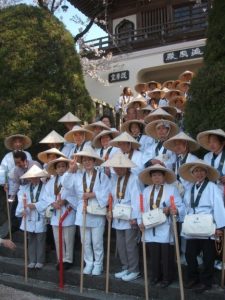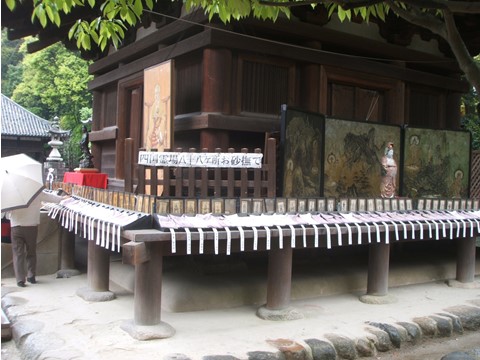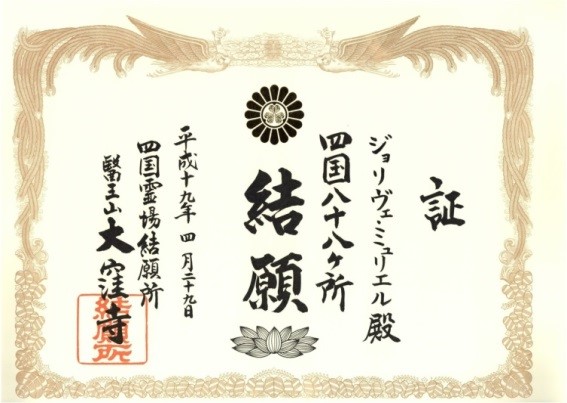

So many books have been written about the Shikoku henro[1], but why are large numbers of people willing to challenge the 1400 km walk the hard way? Based on my own experience as an 歩き遍路 (aruki henro), or walking pilgrim in April 2007, I would like to address the most frequently asked questions : What are the aims of the pilgrims who set out on this journey ? Does the white outfit the pilgrims wear have the power to erase the hierarchies in Japanese society? Do we meet the Daishi on the way? But most of all, is it worth the effort, and is enlightenment (悟り) to be expected at the end of the journey? If not, then what is the outcome of such an exhausting challenge?
Reflecting on my own experience and on the people I met on the camino, I will try to discuss the various changes that do occur at different levels during this “walking meditation”, and how emotional one becomes, as one actually travels “between two worlds”, going through the looking glass…
My presentation started with a word about the origin of the pilgrimage and the symbolic journey towards enlightenment in each of the four prefectures [awakening of the Buddha mind in Tokushima prefecture, followed by ascetic austerities in Kôchi prefecture, the way to enlightenment in Ehime prefecture and the way to Nirvana in Kagawa prefecture].
A number of miniature pilgrimages exist to avoid the hardship of walking all the way, including one in Tokyo Kôya san (高野山、東京別院). Another famous temple on the way is temple 51, Ishiteji (石手寺)in Ehime prefecture, where one can stroke a cushion filled with the holy sand of each of the 88 temples (osuna nade, お砂撫で).

While walking, subtle things start to happen, not to mention what David Reynolds labels introspection therapy (内観).
Each pilgrim has his own reason to embark on the journey, but the warm offerings of the Shikoku people (or osettai, お接待), are also a blessing all the way. My journey happened to be the most powerful experience I have had in 40 years of Japan…

This is a resume of a presentation given at The 10th Convention of The International Association for Japan Studies (国際日本学会), Research Reports Session II: Culture, Language and Social Science, December 13th, 2014 at Kyôto Women’s University, published in the Newsleter11 (pp.48~56).
Short bibliography
On naikan (内観) and on Morita therapy (森田療法)
[1] To mention a few: Ian Reader, Making Pilgrimages : Meaning and Practice in Shikoku, University of Hawai’i Press, 2005, Oliver Statler, Japanese Pilgrimage, London Pan Books, 1984, Dave Turkington, Pilgrimage to the 88 Sacred Places of Shikoku, on line, Don Weiss, Echoes of Incense :a Pilgrimage in Japan, Gateway Books, 1993, Muriel Jolivet, Sur les pas des pèlerins des 88 Temples sacrés du Shikoku: une méditation entre deux mondes, Ebisu #42, Maison Franco- japonaise, Automne-Hiver 2009, etc.